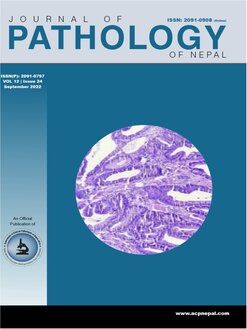Evaluation of tumor infiltrating lymphocytes in breast carcinomas
DOI:
https://doi.org/10.3126/jpn.v12i2.47200Abstract
Background: Among the parameters that have a prognostic and/or predictive significance to therapeutic response, in the case of breast carcinoma, the study of tumor-infiltrating lymphocytes in breast carcinomas is emerging. The present study aimed to access the clinicopathological profiles of tumor-infiltrating lymphocytes in patients with primary breast carcinoma.
Materials and Methods: Information was collected from the archive of the Department of Pathology, about invasive breast cancers diagnosed between April 2019 –March 2020. Hormone receptor status and Ki-67 index were assessed. For tumor-infiltrating lymphocytes, hematoxylin and eosin sections were evaluated following the guidelines of the “International Working Group for tumor-infiltrating lymphocytes in Breast Cancer—2014”.
Results: High tumor-infiltrating lymphocytes were seen in 64.2% and 43.8% in ages < 50 and > 50 respectively. All cases of invasive lobular carcinoma had low tumor-infiltrating lymphocytes. 62.5% of T1 tumors were associated with low TILs whereas 80% of low tumor-infiltrating lymphocytes were T3. 71.4% of lymph node-positive tumors had low tumor-infiltrating lymphocytes. All breast cancers showed lymphocytic infiltrate. 40% of the tumors showed intermediate to high tumor-infiltrating lymphocytes. Lymphocyte-predominant breast cancers were 30%. Among the LPBC, 55.5% were triple-negative breast cancers, 33.3% were HR+, and 11.2% were HER2 positive.
Conclusions: Low tumor-infiltrating lymphocytes presented at an advanced stage of the disease at the time of diagnosis. tumor-infiltrating lymphocytes in breasts decreased with increasing age. LPBCs were predominantly TNBCs. All breast cancers were immunogenic, stating the necessity to report tumor-infiltrating lymphocytes in all breast carcinomas.
Downloads
Downloads
Published
How to Cite
Issue
Section
License
Copyright (c) 2022 Shovana Karki

This work is licensed under a Creative Commons Attribution 4.0 International License.
This license enables reusers to distribute, remix, adapt, and build upon the material in any medium or format, so long as attribution is given to the creator. The license allows for commercial use.




